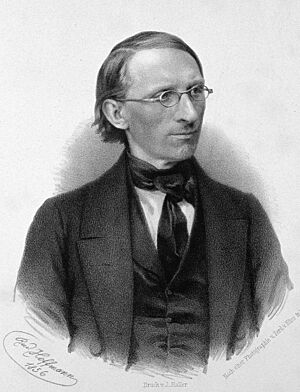Carl Ludwig facts for kids
Quick facts for kids
Carl Ludwig
|
|
|---|---|
 |
|
| Born | 29 December 1816 Witzenhausen
|
| Died | 23 April 1895 (aged 78) |
| Known for | Ludwig–Soret effect Kymograph |
| Awards | Copley Medal (1884) ForMemRS (1875) |
| Scientific career | |
| Fields | Physiology |
Carl Friedrich Wilhelm Ludwig (German: [ˈluːtvɪç]; 29 December 1816 – 23 April 1895) was an important German doctor and scientist. He studied physiology, which is the science of how living things work. His research and teaching greatly changed how we understand the human body. He also improved the tools and methods used in this field.
In 1842, Ludwig became a professor of physiology. Later, in 1846, he taught comparative anatomy, which is about comparing the body structures of different animals. He worked in Zurich and Vienna. In 1865, he moved to the University of Leipzig. There, he created the Physiological Institute, which is now named after him. Ludwig studied many things, like how blood pressure works. He also researched how the body makes and removes urine. He even studied anesthesia, which is used to make people feel no pain during surgery. For his amazing research, he received the Copley Medal in 1884. He also invented a device called the stromuhr, which measures blood flow.
Since 1932, a special award called the Carl Ludwig Honorary Medal has been given out. The German Society for Cardiology gives it to top researchers. These researchers study the heart and blood vessels.
Contents
Carl Ludwig's Early Life and Education
Carl Ludwig was born in a town called Witzenhausen. This town is near Kassel in Germany. He studied medicine at two universities: Erlangen and Marburg. In 1839, he earned his doctor's degree from Marburg.
Marburg became his home for the next ten years. During this time, he studied and taught about the body. He started as a prosector in 1841. This meant he prepared bodies for study. Then, he became a privat-docent in 1842. This is like a private lecturer. Finally, he became an extraordinary professor in 1846.
Carl Ludwig's Career and Legacy
In 1849, Ludwig was chosen to be a professor. He taught anatomy and physiology at the University of Zurich. Six years later, he moved to Vienna. There, he taught at the Josephinum school. This school trained military surgeons.
In 1865, Ludwig received a new job. He was appointed to a brand-new position. This was the chair of physiology at the University of Leipzig. He stayed there for the rest of his life. He passed away on April 23, 1895.
Carl Ludwig's Impact on Science
Carl Ludwig is a very important name in the history of physiology. He played a huge part in changing how this science was studied. This big change happened in the middle of the 1800s.
Ludwig had friends who were also great scientists. These included Hermann Ludwig Ferdinand von Helmholtz, Ernst Wilhelm von Brücke, and Emil du Bois-Reymond. They all met in Berlin in 1847. Together, they believed that living things follow the same rules as non-living things. They thought that the body's functions could be explained by physics and chemistry. They did not believe in special "life forces."
Ludwig wrote a famous book about this idea. It was called Text-book of Human Physiology (1852–1856). But his ideas were clear even in his first paper from 1842. This paper was about how urine is made. His ideas were present in all his later work too.
Ludwig greatly influenced how physiology grew. He made many discoveries. He also created new methods and tools for science. For example, he showed that glands, like the submaxillary gland (which makes saliva), are more than just filters. He found that when they make secretions, there are chemical and heat changes. These changes happen in the glands themselves and in the blood flowing through them.
Ludwig also discovered a new type of nerve. These nerves control how glands secrete. He showed that if these nerves are stimulated, salivary glands keep working. This happens even if the animal's head is removed. This led to a new way of experimenting with organs outside the body.
He also invented the kymograph. This device makes a written record of changes in blood pressure. This invention helped him understand how blood moves in the body. It was also the first time a "graphic method" was used in physiology. This means using graphs or drawings to record changes. For studying gases in the blood, he designed a special blood-pump. This pump has been used a lot, with some changes. He used it to study gases in the lymph (a body fluid). He also looked at gas exchanges in muscles and the role of oxygen in blood.
Carl Ludwig contributed to almost every part of physiology. The only area he didn't focus on was the senses. He was also a great teacher and started his own school of thought. The Physiological Institute at Leipzig became a major center for research. Many original studies came from there. Even though his students' names were on the papers, Ludwig guided every project.
His students learned his methods and ways of thinking. They came from all over Europe. Then, they went back to their home countries. There, they shared and spread his ideas. Ludwig was very skilled with his hands. He disliked messy work. He insisted that experiments on animals be planned very carefully. This was not only to avoid pain (anesthetics were used). It was also to make sure the results were scientifically accurate.
Images for kids
See also
 In Spanish: Carl Ludwig para niños
In Spanish: Carl Ludwig para niños



